Lowell Week in Review: July 16, 2017
Thanks to Paul Marion for pinch hitting for me in this space last Sunday. I was away for a few days visiting Washington, DC, and vicinity. In a way, the trip became a hunt for Lowell connections in American history. I found many, which I will write about separately in the coming days. While away, following local politics was not a priority, but here are some observations made since returning to Lowell:
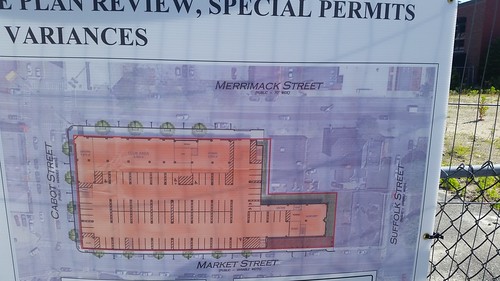
Plan of proposed private dormitory on upper Merrimack St
Private Dormitory on Upper Merrimack Street
Back on June 18, 2017, I wrote about the proposed private dormitory that a developer hopes to construct on the former Jeanne d’Arc Credit Union main branch site on the block formed by Merrimack, Cabot, and Market streets in the Acre neighborhood. The project comes before the Lowell Planning Board this Monday night at 6:30 in the council chamber.
In June, I criticized the preliminary plan for this project for its lack first floor retail or other space that will allow the neighborhood to become involved in the site. Instead, it will wall itself off from everyone who lives around it. This would isolate the building and those who inhabit it from the neighborhood but also make the area less walkable. Even with sidewalks, long bare stretches of bare walls are a turn-off to walkers.
Neighbors also oppose the project because of parking. The developer proposes 93 spaces for 466 beds. Neighbors believe many more cars than that will be associated with the completed development, further burdening the already parking-scarce neighborhood. Other concerns expressed by neighbors involve limited supervision/security for a building expected to house more than 400 college students.
UMass Lowell, I believe, has gone on record opposing the project, saying the beds are not needed for its expected enrollment, and also expressing concern about the lack of institutional supervision over students who reside there.
Balanced against these concerns are the substantial amount of property taxes that this project would pay the city if it is built. With the looming fiscal pressure of a new Lowell High School and other capital projects, city government will look for every opportunity to create new tax revenue to offset these big expenditures.
Monday night we’ll see how the Planning Board balances those priorities.

Mill City Grows community garden on North Common
New Community Gardens
Mill City Grows is building two new community gardens, one on Dane Street near University Crossing, the other near Eagle Park in Centralville. These will join existing community gardens operated by Mill City Grows at Rotary Park, Smith Street, West Third Street and on the North Common.
Mill City Grows is now accepting applications for plots in these two new gardens. A $20 annual fee gets you a 4 x 10 foot raised bed, access to an onsite shed and shared tools, and free attendance at all gardener training workshops. Applications are available on the Mill City Grows website.
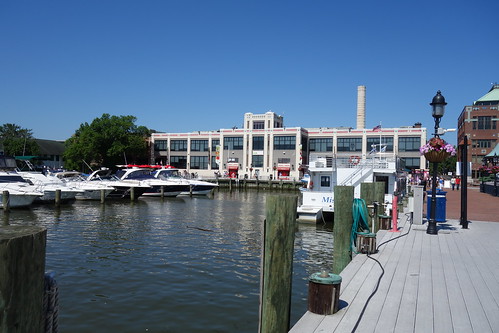
Torpedo Factory, Alexandria, Virginia
The Torpedo Factory & Western Avenue Studios
Back in January 2016, I wrote about a 35th anniversary event at Lowell’s Brush Art Gallery & Studios which featured a panel discussion with Fred Faust, Paul Marion, Rosemary Noon and Susan Gaylord, who reviewed the history of how the Brush Gallery came to be.
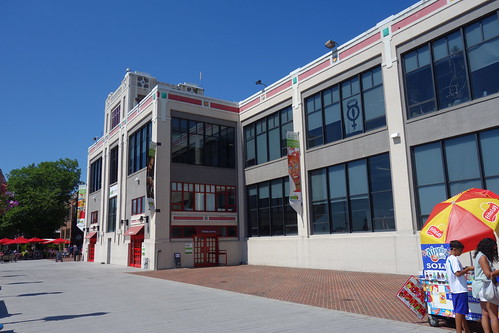
Torpedo Factory
Fred Faust explained that back in the mid-1970s, Paul Tsongas hired him away from WCAP to be a Congressional aide and sent him to Washington to work on legislation to create a national park in Lowell. Instead of living in DC, Fred chose to live across the Potomac in Alexandria, Virginia. There, he discovered a thriving community of artists based mostly in an old US Navy torpedo factory on the bank of the Potomac in Old Town Alexandria. His observations of the Torpedo Factory heavily influenced his vision for what became the Brush Gallery and of subsequent Lowell sites for artists.
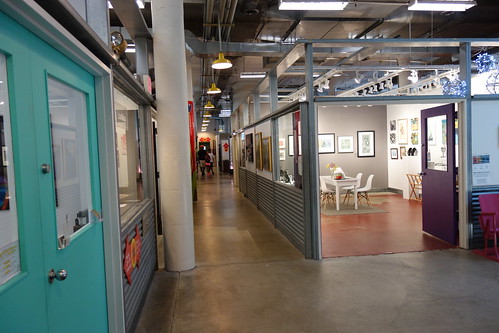
Torpedo Factory interior
Fred’s story about the Torpedo Factory inspired me to visit Alexandria during this recent visit to DC. I found it much like Lowell’s Western Avenue Studios with two major differences.
In Lowell’s favor, Western Avenue Studios is bigger and has a greater selection of artists than does the Torpedo Factory.
In Alexandria’s favor, the Torpedo Factory is in the center of things and is easy to get to. Western Avenue Studios is not, although it could be. I’ve written repeatedly of how Western Ave is cut off from downtown Lowell by man-made obstacles, and of the city’s half-hearted attempts to breach those obstacles.
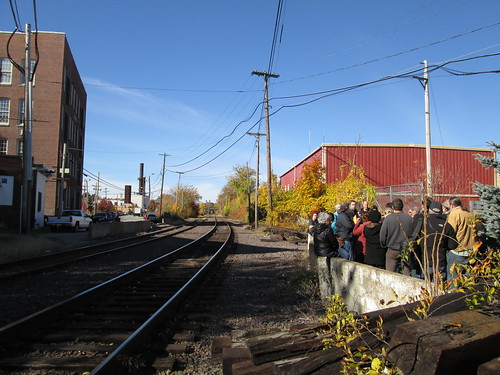
Western Ave Studios (left). People who can’t get to WAS (right)
Western Avenue Studios is a terrific asset for Lowell, but it could be so much better if there was an easy way to walk to it from downtown. As the Hamilton Canal District gets built out, as it inevitably will, gaining this access will become even more important, not just for Western Ave, but for Hamilton Canal and the rest of downtown, too.
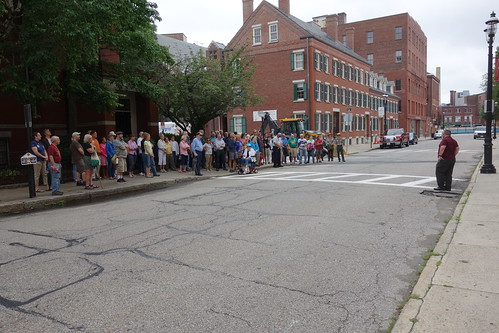
Lowell Walks “Kerouac’s Lowell” tour on Kirk Street
Kerouac Popularity
The 96 people who attended yesterday’s Lowell Walk on “Kerouac’s Downtown” showed once again the drawing power of Lowell’s most famous author. Ably led by Sean Thibodeau and Roger Brunelle, the tour visited Lucy Larcom Park, the Lowell High School clock on Kirk Street, the Kerouac Commemorative, Kearney Square, and the Pollard Memorial Library, where Kerouac claimed that his true education occurred.
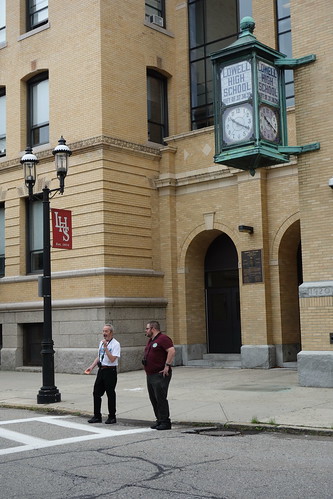
Tour guides Roger Brunelle and Sean Thibodeau under the Lowell High clock made famous by Jack Kerouac
I appreciated much about the tour, but a quote Sean read from Kerouac’s 1953 book, Maggie Cassidy, stood out. In the paragraph copied below, Kerouac writes about a cold March night in 1939, when he, his girlfriend, and his father walked from Lowell High School to Kearney Square for a celebratory soda after a victorious track meet in the LHS Annex (today’s Freshmen Academy).
Here is Kerouac, writing of the benefits of walking over driving in Lowell:
And off we fly, into the bright dry night, stars above the redbrick snows are keen and clear, knives drop from them the big sinewy trees with their claws deep under the pavements are stuck so high in the sky they are like lost silver in the Up, people walk among streetlamps passing massive trunk bases of something living and never pay it a thought—We join the flow of the sidewalks leading downtown—to the Lobster Cot—Merrimack Street—the Strand—the whole dense almost riotous inwards of the city aglow for the Saturday night in that time only fifteen years ago when not everybody had cars and people walked to shop and from buses to shows, not everything was locked-in strange behind tin walls with anxious eyes looking out to deserted sidewalks of modern America now—Pauline, Pa and I could not have laughed and experienced excitement and jumped so joyously as we did that night if we’d been in some automobile grimly buried three in a front seat haggling over traffics in the window of the television set of Time—instead we loped on foot over snowbanks, to dry shoveled sidewalks of downtown, to busy revolving doors of wild midnight sodas.
And if you’re interested in Jack Kerouac, mark the date of March 10, 2018 on your calendar. That’s the date of the Pollard Memorial Library’s first annual On the Road Marathon, a celebration of Jack Kerouac’s birthday with a marathon community reading of On the Road. For more information, check out the library’s “On the Road Marathon” page.
My only thought about privatizing dorms is what happens during the summer? Does the owner of the “dorms” let them sit empty or do they get rented out? Is the layout of the dorm such that while accommodating students with private bedrooms but a common living room and bath and no kitchen, it might not be attractive for non-student rental purposes or will each dorm be a small apartment with all the amenities? Let me say I do not live in the area or have an interest in this project
They have 11 1/2 month leases. The project is one, two and four bedroom apartments with kitchens . . . sizes range from 450 or so to 1200 sf (we think, that info is hard to find) which would fit HUD guidelines for subsidized housing.
The sheer size of this project will impact development decisions along Upper Merrimack Street. The developer swears up and down that his tenants will be detered from bringing cars to school because of lack of parking (and cost of parking). We know that rather than buying a parking decal from the University current students park on residental streets. Even if those tenants don’t originally bring a car to school . . . they will as soon as they realize how hard it is to get basic necessities without a car . . . an issue that neighborhood residents face every day!
Maxine,
Perhaps you’re fighting the wrong fight. Pushing for more onsite parking guarantees tenants will drive. Pushing for less onsite parking precludes tenants from having a car. Forcing “appropriate” onsite parking detracts from the public realm by creating dead zones along the sidewalk, increases congestion, and is a public safety issue for pedestrians.
Eliminating off-street parking creates opportunities to benefit the Acre. By mandating ground floor retail and restaurant space along Merrimack, Cabot, and Market St it would activate street life on Upper Merrimack Street. Small sized ground floor shops would provide jobs for Acre residents, contribute to the commercial tax base, and possibly provide some of the basic necessities currently lacking in the neighborhood.
The developer would be able to charge less per unit by forgoing the cost of providing parking and being able cultivate all the said land.
Looking long term the building could eventually become workforce or low income housing. You can either have a human scale building that adds to the public realm or one that has “appropriate” parking, but you can’t have both.